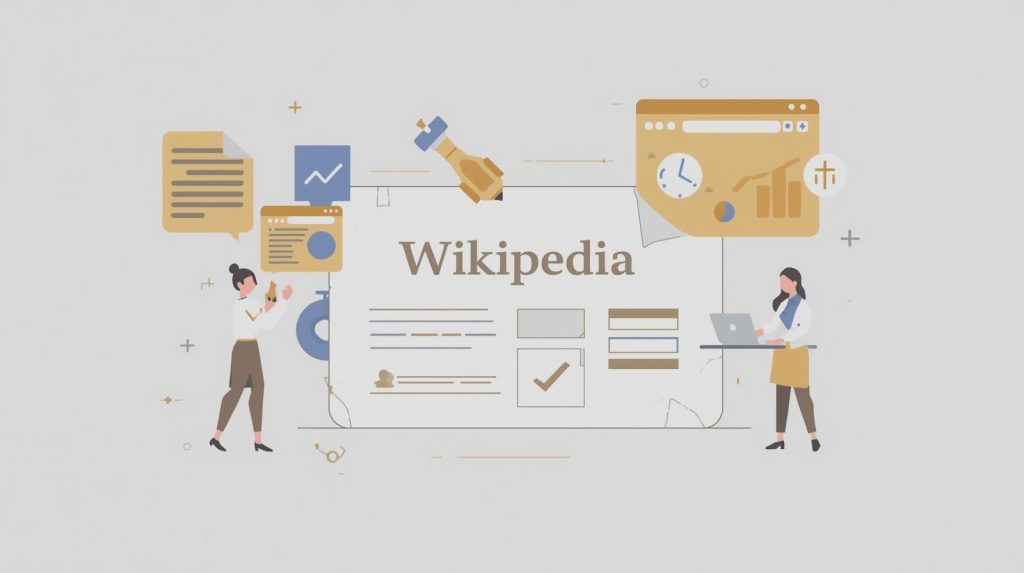A Wikipedia page is often seen as a mark of credibility. However, what appears to be a simple profile is a carefully crafted article built on extensive research, strict policies, and neutral writing. This is why creating a page is far more challenging than it seems.
When it comes to getting a Wikipedia page, there are two main paths. The first is the DIY approach, where you handle all research and writing tasks yourself. The second is to hire an experienced Wikipedia content creation service to manage the process for you.
Both paths can lead to a successful, live page, but each comes with its own costs, risks, and rewards. This guide will show you what you actually save and what you sacrifice with each option. By the end, you will understand how professional Wikipedia page research and drafting work and be able to decide which route is right for you.
Understanding the Fundamentals of Wikipedia Content
Wikipedia content creation is not like writing a blog post or a press release. It is a meticulous process grounded in three core principles:
- Verifiable Facts: Every statement must be supported by independent, reliable sources. Without solid research, a page cannot survive.
- Neutral Tone: Articles must be written from a neutral point of view, reflecting an encyclopedic style rather than a promotional one.
- Proper Formatting: Pages must adhere to strict style rules for everything from headings to citations, ensuring the information is easily verifiable by readers and editors.
Wikipedia is far stricter than conventional publishing because its goal is to be an unbiased reference. It prohibits promotional language, discourages conflicts of interest, and requires transparency. Even small mistakes in sourcing or tone can lead to your page being reversed, edited, or deleted by other editors.
Understanding these fundamentals is the first step in choosing between a DIY and professional approach.
The DIY Path: The Cost of Full Control
Creating your own Wikipedia page offers full control over the content. However, this path requires a significant investment of time and effort.
The DIY process begins with in-depth research to find credible, independent sources that prove your topic’s notability—sources beyond your own website or press releases.
Next, you must master Wikipedia’s extensive style guide. This guide explains how to:
- Maintain a neutral tone.
- Avoid promotional language.
- Structure citations correctly.
- Format headings, infoboxes, and internal links.
The safest way to draft the article is in your user sandbox, allowing you to refine it until it meets community standards. Only then can you submit it for review.
What You Save: The main benefit of the DIY approach is saving money on service fees. You also retain full control over the content and the submission timeline.
What You Sacrifice: The learning curve is steep. Without prior experience, your chance of rejection is much higher. Small mistakes can easily trigger a deletion or a reversal of your edits. The time required for research, writing, and learning the rules is a significant cost in itself.
In short, the DIY path is a low-cost, high-effort option. It works best for individuals with strong independent sources and the patience to navigate Wikipedia’s strict rules.
The Professional Path: Investing in Expertise
Hiring a professional Wikipedia content creation service is a very different experience. Instead of spending weeks learning the rules, you hand the work to experts who are already familiar with the platform.
A good service starts with a notability assessment. They verify if your topic meets the standards before writing a single word, which saves you time and prevents disappointment.
Professional teams then handle the entire process of Wikipedia page research and drafting. They:
- Gather and organize independent sources.
- Write the article in the correct neutral tone.
- Properly format citations, infoboxes, and links.
The best services also handle the submission process and monitor editor feedback to ensure a smooth, successful launch.
What You Save: Professionals have a higher acceptance rate because they understand Wikipedia policies and can avoid common errors that lead to rejection or deletion. You save countless hours of work and reduce the risk of failure.
What You Sacrifice: Cost is the most obvious trade-off. Professional services are not free, and prices can increase for complex topics. You also cede some creative control, as experts may need to adjust phrasing to comply with platform rules.
Hiring professionals is the smarter route if you need a page quickly or if your subject is complex or controversial. Their expertise lowers risk and increases the chance of long-term success.
A Quick Comparison: DIY vs. Professional Service
This simple chart summarizes the main differences between creating a page yourself and hiring a professional service.
Factor | DIY Approach | Professional Service |
Time Investment | Significant hours spent learning rules, researching, drafting, and revising. | Much shorter. Experts handle the bulk of research, writing, and submission. |
Skill Level | Requires learning Wikipedia’s style guide, citation rules, and neutral tone. | Already trained in policies, tone, and formatting. |
Cost | Free in money, but expensive in time and effort. | A paid service fee that varies based on complexity and package. |
Acceptance Rate | Lower. Mistakes or weak sources often lead to rejection or deletion. | Higher. Experience reduces errors and improves the chance of success. |
Long-Term Maintenance | You must monitor for edits or vandalism yourself. | Many services offer monitoring and updates as part of a package. |
This side-by-side view makes it clear: the DIY path saves money but requires heavy effort. Professional services cost more but remove most of the workload and risk.
Hidden Risks and Common Mistakes
Many people underestimate the hidden risks of building a Wikipedia page.
On the DIY path, a primary danger is conflict of interest. Wikipedia discourages people from writing about themselves or their clients without a full disclosure, and skipping this rule can lead to instant deletion. Another common mistake is relying on weak or self-published sources like blogs or press releases. Without strong, independent references, your page is likely to be flagged or removed.
These issues do not disappear when you hire a service. A poor-quality service might promise fast results but use unreliable tactics like promotional links, paid references, or skipping proper disclosures, which can damage your credibility.
Reputable Wikipedia content creation services reduce these risks by:
- Screening topics for notability.
- Selecting only reliable sources.
- Writing in a truly neutral tone.
- Disclosing editing roles when necessary.
They treat Wikipedia as an encyclopedia, not a billboard, which is essential for a page’s longevity.
Post-Publication Maintenance
A live Wikipedia page is not the end of the story. Once published, anyone can edit it. While well-meaning editors might improve it, others may add errors, biased content, or even vandalism. That’s why post-publication maintenance is as important as the initial draft.
On the DIY path, you must monitor the page yourself by checking the “View history” and “Talk” tabs daily. It takes time to track changes, correct mistakes, and discuss edits with other users. If you miss something, inaccurate information can remain on the page for weeks.
Many professional services now offer maintenance plans that include:
- Ongoing monitoring.
- Quick responses to changes.
- Periodic updates with new reliable sources.
This professional oversight helps your page stay accurate and credible over time. Whether you choose the DIY route or hire a service, remember that Wikipedia is a living platform, and protecting your reputation means keeping an eye on your page long after its initial publication.
Deciding What’s Right for You
To choose between the DIY and professional paths, ask yourself a few honest questions:
- Do you have the time to learn and follow Wikipedia’s complex rules?
- Do you already have strong, independent sources to prove your topic’s notability?
- Is your topic simple, or is it complex or sensitive?
- How important is a fast turnaround?
- Are you comfortable managing post-publication maintenance yourself?
If you answered yes to most of these questions—especially if you have strong references ready—the DIY route may work for you. You will save money and maintain full control, but be prepared to invest significant hours in research, writing, and community interaction.
If you are short on time, lack experience, or if your subject is sensitive, hiring a reputable professional service is the smarter choice. You will trade some control and budget for their expertise, a smoother process, and a higher likelihood of long-term success.
Regardless of which path you choose, remember that when it comes to Wikipedia, quality is non-negotiable. A strong foundation protects your page, no matter who builds it.
Frequently Asked Questions (FAQs)
It involves in-depth research, writing in a neutral tone, correct formatting, and citing reliable, independent sources to create a verifiable and encyclopedic article.
The price varies based on the topic’s complexity. Basic pages may start in the low hundreds of dollars, while complex topics or packages that include post-publication monitoring can cost more.
Yes, you can, but you must follow Wikipedia’s strict rules, use reliable sources, and be prepared for a steep learning curve. The process is challenging and requires a significant investment of time.
Disclosure: We are a dedicated content marketing agency guiding small and medium businesses through their journey to the first page of Google.

Admin at Search Marketing Experts, publishing insightful blog posts on SEO, digital marketing, and strategies to help businesses grow online.

